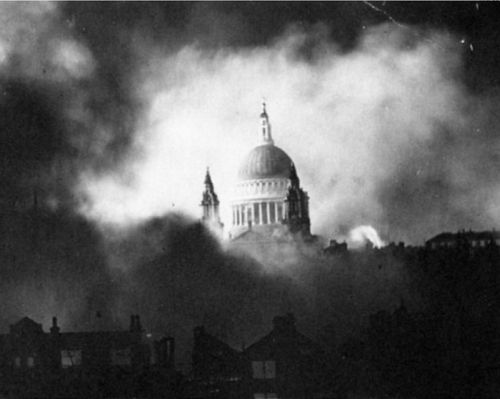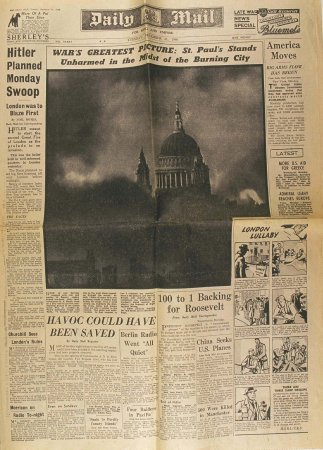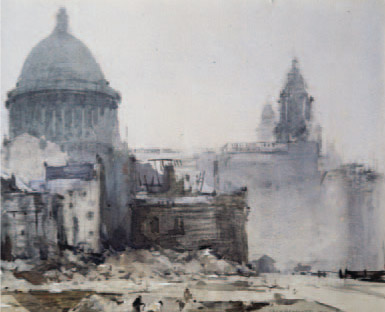Image: St Paul’s Rides the Blitz December 9, 2010
Author: Beach Combing | in : Contemporary , trackbackBeachcombing should start today with an apology. In his mission statement about his Image series he promised to put up only little known photographs and paintings. And yet here he is, six months on, offering the most famous of all British pictures from 1940, as if it were a scoop.
Sorry.
Beachcombing only hopes the reader will agree that this is a picture that deserves more attention.
29 December 1940, the end of the worst year in British history, sees a heavy attack on central London: Germany’s (late) Christmas present to the British people – they didn’t even have the manners to deliver on time! – was the ‘Second Great Fire of London’. Incendiary bombs rained down on the capital causing first conflagration and then a fire storm.
Thousands of buildings were to be destroyed over the next hours and days – there was a follow up attack the night after – and St Paul’s itself, Britain’s most famous church was threatened.
According to British wartime mythology St Paul’s was saved by a miracle. But the truth is that Britain was all out of miracles by the end of 1940.
The Cathedral was saved, first, by an express order from Churchill, who effectively sacrificed other parts of the city centre. Second, and most importantly by cockney firemen, a number of whom died in the three-day battle to shield the cathedral. And, third, by volunteers who poured sand on the incendiary bombs that landed on St Paul’s roof.
Today, in more secular times, Britain’s war effort is remembered as an act of democratic daring-do against Continental totalitarians. But in the war itself Christian imagery was preferred by many of Britain’s war leaders, especially those on the right. Churchill’s speeches, for example, are larded with reference to ‘crusades’ and ‘Christian civilisation’.
The subliminal – and as it happens correct – message was that Germany and Italy’s high ups were not typically to be found in the front pew come Sunday morning.
This picture, taken from the roof of the Daily Mail building by Herbert Mason, plugs into this Christian schemata.
The Cathedral is cloaked in a sheen of light as the fires rage around without ever touching St Paul’s consecrated stones. The gutted buildings in front are a reminder that this is all deadly, deadly serious, while the crooked take stops the picture seeming ‘staged’; any hint of sugar and spice disappears in that skew.
Interestingly the picture became an instant (self-declared) classic with the Daily Mail running it on its front page on December 31 under the banner headline ‘War’s Greatest Picture’.
Forty thousand died in the London Blitz and many more, of course, were injured.
But this was over months and months. Compare it to twenty plus thousand in two nights in Dresden or one hundred thousand over two nights in Tokyo.
The truth is that London was lucky to be hit so early in the war, while most of Britain’s fighters were operational and before bombs increased in killing power to the truly terrifying levels of 1944 and 1945.
Ask Britons today about the London Blitz and they think ‘resistance’ not ‘death’.
This was true of wartime Britons as well. When British warriors prepared to disembark at Normandy in 1944 they were encouraged to ‘Remember Dunkirk! Remember Coventry!’ by the loudspeakers, respectively the great military and the great civilian disaster of the war. No mention was made of the London bombings.
One of Britain’s worst cultural losses was Coventry cathedral – there is a heartbreaking radio description from the then bishop (?) describing Coventry’s old medieval centre turning into a furnace.
The most painful memory of landmark loss in the capital were a few livery halls and MPs having to walk over broken glass in Parliament. Still it was a close run thing for St Paul’s.
Beachcombing is always grubbing after interesting and, ideally, little known historical pictures. Drbeachcombing AT yahoo DOT com





